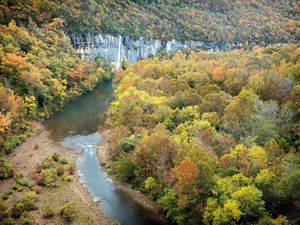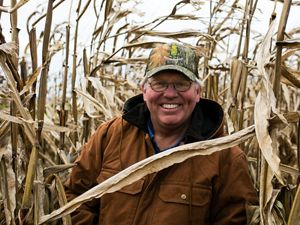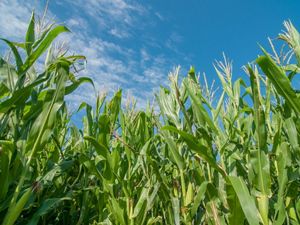Protecting Farmland and Water Quality in Alabama
Farm Bill funding helps Alabama farmers adopt key stream conservation practices.
Alabama boasts a thriving agricultural industry of 43,000 farms producing such in-demand commodities as poultry, cattle, cotton, soybeans and peanuts. Coexisting alongside the farming industry are Alabama’s river systems, which are among the most biologically diverse in the nation. Indeed, Alabama ranks number one for its varieties of freshwater mussel species, freshwater fish species, freshwater snails, crayfish and freshwater turtles.
Now, a major federal award through the Farm Bill will help Alabama farmers protect their lands from streambank erosion and at the same time maintain and improve the water quality in three biologically significant systems in north Alabama—the Paint Rock River, the Locust Fork of the Black Warrior River and Big Canoe Creek. In April 2020, the Natural Resources Conservation Service (NRCS) announced that the project, “The Streambank Restoration Initiative,” was selected for a $1 million award in a five-year program through the NRCS Regional Conservation Partnership Program (RCPP).
Coordinated by The Nature Conservancy in Alabama and involving multiple state and federal agencies, Alabama’s Streambank Restoration Initiative will help restore degraded streambanks and enhance aquatic habitats. The RCPP, a federal program, was created in the 2014 Farm Bill to focus on watershed-level resource concerns and to help more members of the agricultural community adopt conservation practices in areas that need it the most. RCPPs bring together partners and additional funding to maximize on-the-ground impact. (TNC is also serving as the lead on two other five-year RCPP projects that were announced in April 2020.)
Working with Producers to Improve Streams
TNC selected the three target watersheds because of their biological richness. Those selections were supported by the Alabama Rivers and Streams Network (ARSN). ARSN is a consortium of federal and state agencies, private corporations and nonprofits, all working to protect water resources. All three target watersheds have significant farming presence in addition to high species diversity and several federal and state protected species.
More than 30 federally listed endangered and threatened species live in these three watersheds, including the Black Warrior waterdog (a salamander), the flattened musk turtle and the trispot darter, a fish recently rediscovered in the Big Canoe Creek watershed after being thought extinct in Alabama. The Streambank Restoration Initiative will improve habitat and water quality that these species depend on.
With the support of the RCPP, TNC and partners will reach out to willing farmers and landowners in each watershed and offer a suite of conservation and stream restoration practices. These practices will benefit the farmers by halting or reducing erosion on their farms, protecting their land and improving its wildlife habitat and land value. These practices will also benefit the environment by reducing sediment and runoff flowing into these rivers and streams, which protects the health of aquatic species.
“One of the biggest threats to water quality and aquatic species in these systems is excess sediment,” says Jason Throneberry, director of Alabama freshwater programs for TNC. “So what we’re trying to do is stabilize failing streambanks and prevent the thousands of metric tons of sediment that are entering these streams annually.”
Quote: Jason Throneberry
I think seeing is believing. We can talk to landowners about the science all day long, but it’s different when they can see the benefits for their land and the streams with their own eyes.
Landowners Will Benefit From Cost-Share
The suite of practices offered in the program will focus on stream restoration using natural channel design, which consists of re-grading the stream to change its slope and incorporating a combination of wood and rocks set into the bank to prevent erosion. In addition, the program will include tree plantings that will protect the stream bank and improve water quality, and in some cases fencing and alternative water systems to keep livestock out of streams.
Because of federal cost-share funding, the landowners will only have to pay a small percentage of the cost—around 20-25 percent. In fact, the landowners’ cost-share in many cases may be fulfilled by in-kind contributions, such as fencing or conservation work the landowner contributes, or land the farmer takes out of production to restore it to natural habitat.
“Every site’s different,” says Alana Reynolds, watershed coordinator for TNC in Alabama. “It may not be a cattle farm every time. It might be a row cropper. Or they might only have timber, and it might only be a forestry operation. So we have a suite of practices we apply depending on the situation.”
The project will be implemented through a partnership between TNC, NRCS, United States Fish and Wildlife Partners for Fish and Wildlife Program, Geological Survey of Alabama, the Alabama Department of Environmental Management, and the Alabama Department of Conservation and Natural Resources.

The Value of Demonstration Projects
TNC has been working with farmers and landowners on river and stream projects for many years. One result of that track record is that TNC has several completed stream restoration projects on farms that serve as demonstration sites for landowners TNC is trying to recruit.
“In every watershed, we try to have demonstration project that has all the elements so we can show other landowners what’s involved and how it can look,” says Jason Throneberry. “I think seeing is believing. We can talk to landowners about the science all day long, but it’s different when they can see the benefits for their land and the streams with their own eyes.”
The Streambank Restoration Initiative is slated to get underway in early 2021. The expectation is that TNC and partners will work with at least seven landowners during the course of the five-year funding.




